
Padmasambhava, also known as Guru Rinpoche and the Lotus from Oḍḍiyāna, was a tantric Buddhist Vajra master from India who taught Vajrayana in Tibet. According to some early Tibetan sources like the Testament of Ba, he came to Tibet in the 8th century and helped construct Samye Monastery, the first Buddhist monastery in Tibet. However, little is known about the actual historical figure other than his ties to Vajrayana and Indian Buddhism.

Nyingma is the oldest of the four major schools of Tibetan Buddhism. It is also often referred to as Ngangyur, "order of the ancient translations". The Nyingma school is founded on the first lineages and translations of Buddhist scriptures from Sanskrit into Tibetan in the eighth century, during the reign of King Trisong Detsen.
Shechen Monastery is one of the "Six Mother Monasteries" of the Nyingma tradition of Tibetan Buddhism. It was originally located in Kham, Tibet, but was destroyed in the late 1950s during the Cultural Revolution and was rebuilt in Nepal in 1985.

Kyabje Dudjom Jigdral Yeshe Dorje was known as Terchen Drodül Lingpa and as Dudjom Rinpoche. He is considered by many Tibetan Buddhists to be from a line of important Tulku lineage, and a renowned Tertön. Lineage wise, he was a direct incarnation of both Padmasambhava and Dudjom Lingpa (1835–1904). He was a Nyingma householder, yogi, and a Vajrayana and Dzogchen master. According to his disciple Khenpo Tsewang Dongyal, he was revered as "His Holiness" and as a "Master of Masters".
The Guhyagarbha Tantra is the most important Buddhist tantra of the Mahayoga class and the primary tantric text studied in the Nyingma tradition. It is the main Nyingma source for understanding empowerment, samaya, mantras, mandalas and other Vajrayana topics, and has influenced the Dzogchen tradition. The Nyingma scholar Longchenpa sees it as "the highest summit of all vehicles, the source of all verbal transmissions, the great great shortcut of the vehicle of all Buddhas of the three times, the most secret."
Anuyoga is the designation of the second of the three Inner Tantras according to the ninefold division of practice used by the Nyingma school of Tibetan Buddhism. As with the other yanas, Anuyoga represents both a scriptural division as well as a specific emphasis of both view and practice.
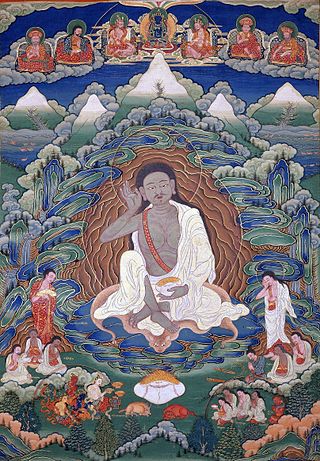
In Tibetan Buddhism and Bon, a ngagpa (male), or a ngagmo (female) is an ordained non-monastic practitioner of Dzogchen and Tantra. Traditionally, many Nyingma ngakpas wear uncut hair and white robes and these are sometimes called "the white-robed and uncut-hair group".
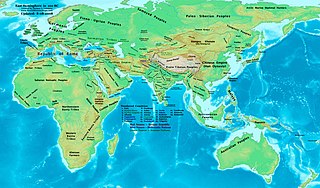
Oḍḍiyāna, was a small region in early medieval India, in present-day Swat District of modern-day Pakistan. An alternate theory places its location in what is now the modern Indian state of Odisha, though this is improbable.
Sri Singha was the teacher of Padmasambhava, Vimalamitra, and Vairotsana. He was a principal student and dharma-son of Mañjuśrīmitra in the Dzogchen lineage, and is credited by the Nyingma school with introducing Dzogchen to Tibet.
According to the Nyingmapa tradition of Tibetan Buddhism, the Dzogchen masters Manjushrimitra and Shrisimha were already active in the Tantric milieu in India independently. However, Manjushrimitra, a learned scholar of Brahman origin, was evidently an adherent of the Yogachara school before his becoming a disciple of the mysterious Prahevajra or Garab Dorje from the country of Uddiyana. It should also be recalled that his disciple Shrisimha was said to have born and resided for some time in China before coming to India. And that the latter's disciple Vimalamitra visited China before and after he came to Tibet and transmitted the Dzogchen teachings to his disciples at Samye Monastery.
Rongzom Chökyi Zangpo, widely known as Rongzom Mahapandita, Rongzom Dharmabhadra, or simply as Rongzompa, was one of the most important scholars of the Nyingma school of Tibetan Buddhism. Together with Longchenpa and Ju Mipham, he is often considered to be one of the three "omniscient" writers of the school. His elder contemporary Atiśa (980–1054) considered Rongzompa to be an incarnation of the Indian ācārya Kṛṣṇapāda, the Great. The Tibetan historian Gö Lotsawa (1392–1481) said of Rongzom that no scholar in Tibet was his equal.
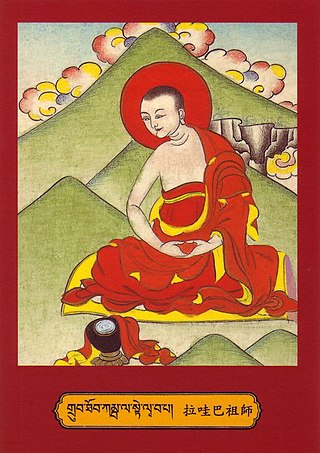
Lawapa or Lavapa was a figure in Tibetan Buddhism who flourished in the 10th century. He was also known as Kambala and Kambalapada. Lawapa, was a mahasiddha, or accomplished yogi, who travelled to Tsari. Lawapa was a progenitor of the Dream Yoga sādhanā and it was from Lawapa that the mahasiddha Tilopa received the Dream Yoga practice lineage.
Tibetan astrology is a traditional discipline of the Tibetan peoples that has influence from both Chinese astrology and Hindu astrology. Tibetan astrology is one of the 'Ten Sciences' in the enumeration honoured by this cultural tradition.
Getse Mahapandita (1761–1829) was an important Nyingma scholar affiliated with Kathok Monastery.
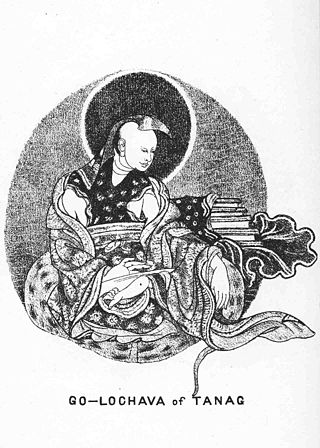
Gö Khugpa, 'Gos Khug-pa Lhas-btsas, Gö Kuk-ba-hlay-dzay, is also written as Khug-pa-Lhas-tsi, or simply 'Gos, was a famous Tibetan monk and translator of the 11th century.

Ma Rinchen Chok, is numbered as one of the twenty-five principal disciples of Padmasambhava. Rinchen Chok was also a senior disciple of Vimalamitra. Rinchen Chok was an important lotsawa in the first wave of translations and was one of the first seven monks ever to be ordained in Tibet by Shantarakshita, known as the 'seven men who were tested'. The ordination lineage was Sarvastivadin.
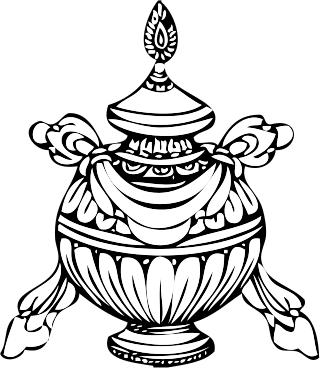
The Sheja Dzö or "Treasury of Knowledge" is a voluminous work by Jamgon Kongtrul (1813–1899). It is constituted by a root text in verse "The Encompassment of All Knowledge" and an autocommentary in prose, 'The Infinite Ocean of Knowledge'. The Treasury of Knowledge is widely considered Jamgon Kongtrul's masterpiece, covering the full spectrum of Buddhist history according to the knowledge then current in the Himalayas; the Abhidharma through the lens of Vasubandhu ; the Buddhist philosophy preserved, categorized and developed in the Himalayas; and the many streams of Buddhist sādhanā both exoteric (sutrayana) and esoteric (vajrayana), transmitted to, maintained and developed by the many trans-Himalayan lineages, such as Mahamudra and Dzogchen. The breadth of the Sheja Dzö is encyclopedic and its approach ecumenical. The root text in verse is terse and ostensibly glib approaching telegraphic. Whereas, the tone and register of the commentary is non-sectarian in regards to the many systems of Buddhadharma it enshrines. The Sheja Dzö is the central reference and general auspice work in Rimé movement literature.

A charnel ground is an above-ground site for the putrefaction of bodies, generally human, where formerly living tissue is left to decompose uncovered. Although it may have demarcated locations within it functionally identified as burial grounds, cemeteries and crematoria, it is distinct from these as well as from crypts or burial vaults.
Kukuraja was a mahasiddha within the lineages of Esoteric Buddhism and he was contemporaneous with Indrabhuti of Sahor in Oddiyana and Kambalapada.
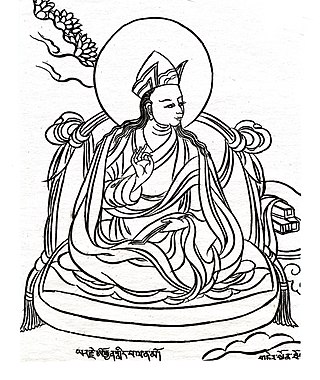
Orgyen Lingpa, was one of the greatest Tibetan tertöns or treasure-finders of the 14th century.
At the age of twenty-three he is said to have discovered an extensive treasure inventory at Samye Monastery in the Red Stupa."
He discovered texts, images, ritual objects and jewels, chiefly at Shetak, Yugang Drak, and Drachi Drakpoche. Of the 100 texts that were revealed by him, the Katang Denga are the most important to have survived. These five volumes chronicling the period of the Emperor Trisong Detsen include the Pema Katang, the most authoritative legendary biography of Guru Rinpoche. Orgyen Lingpa was born at Yarje in 1323.
Gyurme Dorje was a Scottish Tibetologist and writer.










